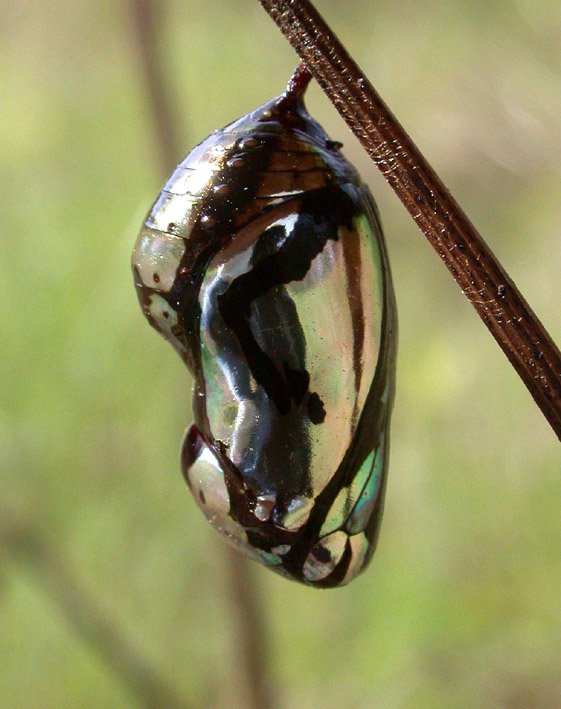Common Crow Butterfly
Oleander Butterfly
The Common Crow or Oleander Butterfly has a distinctive silvery pupa (chrysalis) that can often be found on oleander bushes in Sydney parks and gardens during summertime.
Identification
The adult butterfly is easily recognised by its dark brown wings that are spotted white along the margins. The male's forewing has a bow-shaped hind margin, while the female's is straight.
The adult butterflies only have four normal legs, as the first pair of legs is not fully developed (a common feature of the Family Nymphalidae).
The larvae (caterpillars) are orange-brown with a dark underside, with each segment striped black and white across the top. The sides of the caterpillar have a white band or series of white spots. Eight paired fleshy appendages ('tentacles') are found on the upper side of the second, third, fifth and eighth segments.
The pupa (chrysalis) is stout (about 1.8 cm long) and shiny, reflecting silver to gold.

Chrysalis (pupa) of Common Crow or Oleander Butterfly, Euploea core.
Image: Bruce Hulbert© Bruce Hulbert
Distribution
The Common Crow Butterfly is found in Queensland and northern New South Wales, and also occurs across northern Australia as far west as Onslow in Western Australia. It has on occasion extended its range as far south as Victoria, and pupae have been found in Cootamundra and Kandos, New South Wales, which are west of the Great Dividing Range. It has been found in Alice Springs, Adelaide and Lord Howe Island. It has also been common at times in Sydney (1947-48; 1954-55 and more recently).
Seasonality
Adult Common Crow Butterflies overwinter together for protection in large aggregations of one to two thousand butterflies. The butterflies go into a dormant state in which they live on their fat reserves and nearby nectar sources until warmer weather returns. These aggregations occur in sheltered coastal sites and on offshore islands in the tropics and subtropics of northern and eastern Australia.
Other behaviours and adaptations
The Common Crow Butterfly has a strong scent that may allow predators to identify it as inedible. It also produces (from chemicals in its food plants) toxins so strong that eating just one butterfly may induce a bird to vomit. However, not all birds are sensitive to the toxins, and common invertebrate predators and parasites such as spiders, dragonflies, flies and wasps suffer no ill effects from eating these butterflies.
Life history cycle
The female Common Crow Butterfly lays its eggs on the leaves of plants that have a milky sap. In Sydney, these include: oleander (Nerium oleander, Family Apocynaceae), and two species of figs (Family Moraceae), the Port Jackson Fig (Ficus rubiginosa) and the Weeping Fig (F. benjamina). Other food plants include garden plants such as Chilean Jasmine (Mandevillea laxa), Chinese Star Jasmine (Trachelospermum jasminoides), Stephanotis spp, and Milkweeds (Asclepias spp).
The eggs are yellowish, ribbed vertically and longer than they are wide. When the caterpillars hatch, they begin to feed upon the milky sap. The caterpillar stage lasts for about 21 days (in Sydney).
The newly formed pupa is a cream colour but becomes silvery a day after construction. The pupal stage lasts for about two weeks, with the developing butterfly becoming visible inside the transparent pupal skin. The adult butterfly is ready to fly within eight hours of emerging.
The adult butterfly has a life span of 11 - 13 weeks. The adults feed upon nectar from various flowering plants, including eucalypts.


